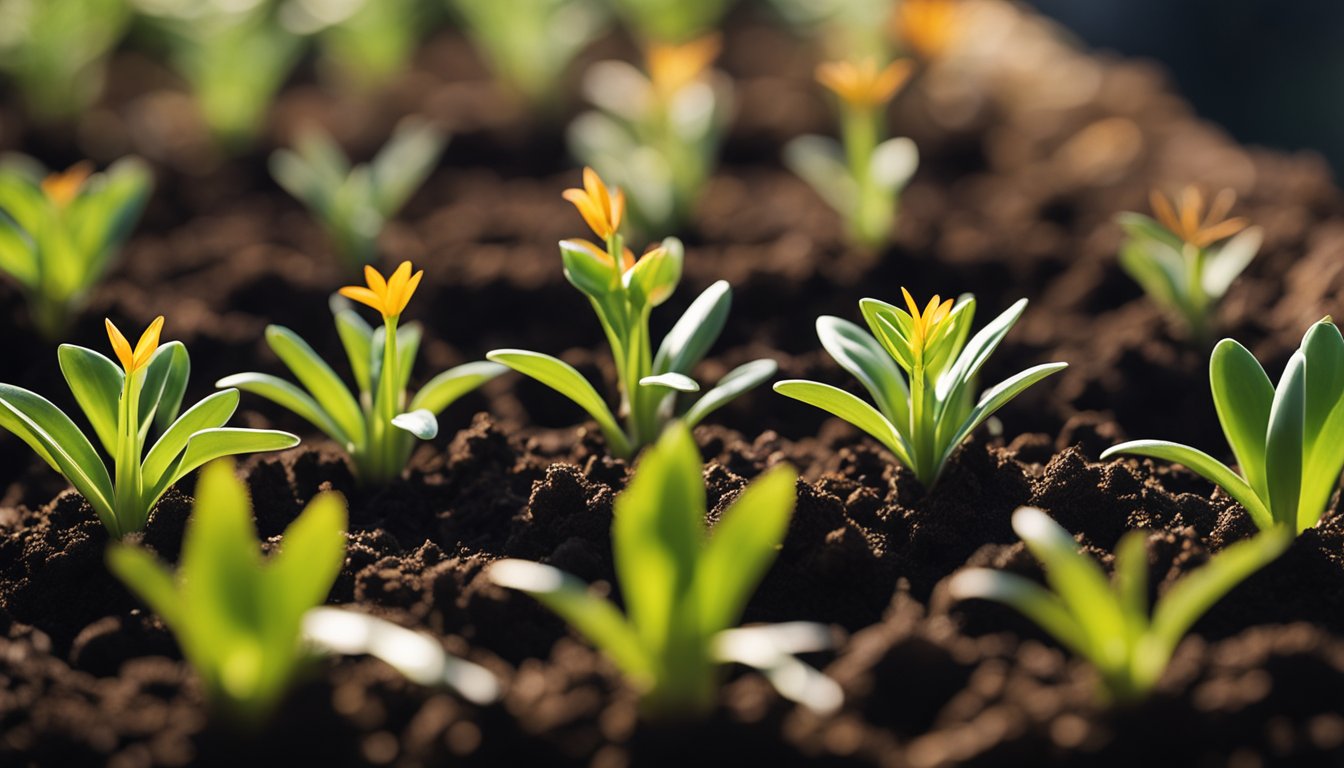If you’re looking to add a splash of vibrant color to your garden, the orange star plant is a fantastic choice. With its stunning star-shaped blooms and easy-care nature, it’s perfect for both seasoned gardeners and beginners alike. I’ve found that nurturing this beauty not only brightens up my space but also brings a sense of accomplishment as it thrives under my care.
Understanding Orange Star Plants
Orange star plants stand out for their unique charm and resilience. They add bright colors to gardens while requiring minimal care.
Origin and Characteristics
Orange star plants, scientifically known as Graptopetalum paraguayense, hail from the arid regions of Mexico. Their succulent leaves store moisture, which helps them survive dry spells. The star-shaped flowers bloom in vivid hues, typically orange and yellow, attracting pollinators. These plants thrive in well-drained soil and prefer full sun, making them perfect for sunny spots. With good drainage and bright light, they flourish with little hands-on help.
Varieties of Orange Star
Several varieties exist within the orange star family, each offering something special. The Graptopetalum paraguayense has thick, waxy leaves and stunning flowers. Another popular option is the Graptoveria, which boasts unique leaf shapes and vibrant colors. You’ll find hybrids that combine traits for even more variety. These different types add excitement and diversity to gardens or indoor spaces, keeping things fresh and lively. Whether you fancy compact types or larger ones, there’s an orange star to match your style.
Preparing for Growth

Growing orange star plants requires some preparation. Understanding their needs helps in creating the perfect environment for vibrant blooms.
Choosing the Right Location
I look for a sunny spot when selecting a location for my orange star plants. Full sun exposure boosts growth and enhances flower color. Areas with good airflow prevent issues like mold. Avoid shaded spots; these plants prefer to bask in sunlight, like enjoying a warm beach day. Choose a spot that can showcase their beauty, maybe even near a path where passersby can admire the star-shaped flowers.
Soil Requirements
Soil quality plays a crucial role in the success of my orange star plants. They thrive in well-drained soil, which prevents root rot and encourages healthy growth. I often mix potting soil with sand or perlite to improve drainage. Finding a balance in soil texture matters. Too heavy leads to soggy roots, while too light can dry them out. A slightly acidic to neutral pH, around 6.0 to 7.0, works well for these beauty queens, ensuring they’re happy and thriving. Regularly checking soil moisture levels keeps me on track; I only water when the top inch feels dry, which helps avoid fussing over a thirsty plant.
Planting Orange Star

Planting an orange star is a rewarding process that adds vibrant color to any garden or indoor space. These resilient plants bring joy and beauty with minimal effort.
Seeds vs. Seedlings
Choosing between seeds and seedlings matters. Seeds require patience, as they’ll take time to sprout. I enjoy starting from seeds for the fun of seeing new life emerge, but it can take several weeks before they become seedlings. Seedlings, on the other hand, let me skip the waiting game. They already have a head start and are ready for planting. By using seedlings, I can see growth faster, adding instant satisfaction to my gardening experience. I often find nurseries stocked with healthy seedlings, making the choice easier.
Planting Techniques
Using simple planting techniques ensures success with orange star plants. Start by digging a hole that’s about twice the size of the root ball. Make sure the soil is loose and well-drained to prevent water from pooling around the roots. Next, place the plant in the hole, making sure the top of the root ball sits level with the surrounding soil. I like to pack the soil gently around the base to provide stability.
Ample sunlight plays a crucial role in growth, so I place my orange stars where they’ll catch several hours of direct light daily. Watering should happen immediately after planting to help the roots settle in, but I avoid overwatering, these plants prefer a dry spell. Don’t let their beauty fool you; they’re tough little guys! If you plant them right, they’ll thrive with minimal fuss.
Care and Maintenance

Taking care of orange star plants is straightforward. With a few simple practices, maintaining their health becomes easy and rewarding.
Watering Guidelines
I water my orange star plants when the top inch of soil feels dry. This method prevents overwatering and protects roots from rot. I usually check the plants every week, especially during hot weather. To keep things interesting, I let the water soak through the pot’s drainage holes. Watching the water trickle out feels satisfying. It’s like giving them a refreshing drink on a hot day!
Fertilizing Practices
Feeding my orange star plants is simple as well. I use a balanced fertilizer once a month during the growing season. Diluting the fertilizer to half strength helps avoid nutrient overload. I mix it in the water, turning the routine into a mini-science experiment. During the fall and winter, I skip fertilizing since the plants go dormant. Less is more during those quiet seasons. Trust me; these plants thrive better without too many nutrients.
Common Issues and Solutions
Growing orange star plants can be a joyful experience. However, issues may arise that require attention. Here’s what I’ve encountered and how to resolve these common problems.
Pests and Diseases
Pests often sneak in when I least expect it. Aphids and mealybugs can target the succulent leaves. To tackle these pests, I use a gentle soap solution. I mix one tablespoon of dish soap with water in a spray bottle. A quick spray every few days usually does the trick. Keep an eye on the plants; early detection makes a difference. Fungal diseases might also appear, especially with excessive moisture. I always ensure good airflow around my plants. If I spot mold, I quickly remove affected leaves and reduce watering.
Before You Go – How to Grow Orange Star Plants?

Growing orange star plants has been a truly rewarding experience for me. Their vibrant colors and unique shapes not only brighten up my garden but also bring a sense of joy and accomplishment. With their low-maintenance needs and resilience to dry conditions, these plants are perfect for anyone looking to add beauty to their space without too much hassle.
By following the right care practices and being attentive to their needs, I’ve seen my orange star plants flourish. Whether you’re a seasoned gardener or just starting out, I encourage you to give these stunning plants a try. You might just find that they become a favorite in your garden too. Don’t forget to add The Herb Prof to your favorites so you don’t miss out on future articles.
References – How to Grow Orange Star Plants?
Little Herb Encyclopedia, by Jack Ritchason; N.D., Woodland Publishing Incorporated, 1995
The Ultimate Healing System, Course Manual, Copyright 1985, Don Lepore
Planetary Herbology, Michael Tierra, C.A., N.D., Lotus Press, 1988
Handbook of Medicinal Herbs, by James A. Duke, Pub. CRP Second Edition 2007
The Complete Medicinal Herbal, by Penelope Ody, Published by Dorling Kindersley
Check the Following Articles
Does Chamomile Tea Have Caffeine?
Amazing Guava Benefits for Your Health & Skin
Home Remedies for Fungal Infection
Frequently Asked Questions – How to Grow Orange Star Plants?
What is the orange star plant?
The orange star plant, scientifically known as Graptopetalum paraguayense, is a succulent known for its striking star-shaped flowers and vibrant color. It thrives in sunny conditions and well-drained soil, making it an excellent choice for both novice and experienced gardeners.
How do I care for orange star plants?
Caring for orange star plants involves checking soil moisture regularly and watering only when the top inch feels dry. They require adequate sunlight and well-drained soil. Fertilize monthly during the growing season with a diluted balanced fertilizer, skipping fertilization in fall and winter.
Where should I plant orange star plants?
Plant orange star plants in a sunny location to maximize growth and enhance the color of the flowers. Good airflow around the plants is essential to prevent mold and fungal diseases, so choose a spot with ample space.
How often should I water orange star plants?
Water orange star plants when the top inch of soil feels dry, generally once a week in hot weather. Ensure the pot has drainage holes to allow excess water to escape, preventing root rot.
What pests affect orange star plants, and how can I control them?
Common pests include aphids and mealybugs. Control them by using a gentle soap solution. Early detection is key, and maintaining good airflow helps prevent fungal diseases. Remove affected leaves if mold appears and reduce watering.
Can I grow orange star plants from seeds?
Yes, you can grow orange star plants from seeds, but it requires patience as they take longer to sprout. Alternatively, using seedlings provides a quicker option for establishing your garden with these vibrant plants.
What type of soil is best for orange star plants?
The best soil for orange star plants is well-drained soil to prevent root rot. A mix of potting soil with sand or perlite is recommended to ensure optimal drainage and health for the plants.

